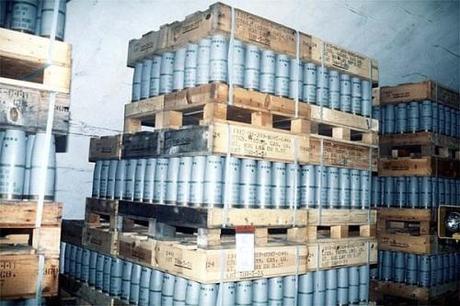WND EXCLUSIVE
ISIS SCORES BIG WITH IRAQI WMDS
Saddam’s manufacturer also joins terror army

Sarin stockpiles
WASHINGTON – The terrorists running amok in Iraq – members of the Islamic State of Iraq and the Sham – may have access to a secret sarin poison gas production facility in northeast Iraq as a result of a new alliance with a top military commander who previously was an aide to executed Sunni Iraqi leader Saddam Hussein, WND has learned.
And they also may be working with a man who’s known for his expertise in making sarin, a manmade toxin that was developed in Germany and can, according to the Centers for Disease Control, produce loss of consciousness, convulsions, paralysis and death in victims who are exposed.
The revelations comes as the State Department acknowledged that ISIS has captured a stockpile of old chemical weapons at the Al Muthanna chemical weapons production complex as its fighters sweep through Iraq’s Sunni- controlled region.
The access to a sarin poison gas production facility, and the man with the expertise to operate it, is the result of a new alliance between the brutal jihadist fighters and Izzat Ibrahim al-Douri, who was a top military commander and vice president to the deposed Saddam Hussein.
According to sources, Douri heads the Naqshbani Army, which is a coalition of Sunni groups in Mosul, a city which recently was overrun by ISIS. The sources added that representatives of Douri recently met with ISIS leader Abu Bakr al-Baghdadi.
ISIS has swept through Iraq toward Baghdad, which is being defended by troops of the government of Shiite Prime Minister Nouri al-Maliki, in recent days. The coalition of terrorists has included Sunni jihadist groups, and now apparently members of the Naqshbandi Army after an alliance, sources said.
The Naqshbandi Army is a resistance group of underground Baathists and Islamist militant insurgency groups in Iraq. It emerged in December 2006 following the execution of Hussein.
Douri’s alliance gives ISIS’ Baghdadi access to a facility that produces sarin nerve gas under the direction of former Iraqi Military Industries Brig. Gen. Adnan al-Dulaimi.

Izzat Al-Duri
Dulaimi was a major player in Saddam’s chemical weapons production projects. He has been working in the Sunni-controlled region of northwestern Iraq where the outlawed Baath party is located and produces the sarin.
A WND request to the State Department for a response to the revelation that ISIS may already have access to a working sarin poison gas production facility as a result of the Douri alliance with ISIS went unanswered.
Similarly, the State Department did not respond to a WND inquiry as to why old chemical weapons stockpiles at the Al-Muthana chemical complex were never destroyed before U.S. troops left Iraq in December 2011.
The Iraqi production of poison sarin nerve gas recently was confirmed in a classified document from the U.S. intelligence community’s National Ground Intelligence Center, or NGIC.
The document was classified Secret/Noforn – “Not for foreign distribution.”
The document revealed that “AQI” had produced a “bench-scale” form of sarin in Iraq and had transferred it to Turkey.
AQI, or al-Qaida in Iraq, was the precursor to the al-Qaida splinter group ISIS, which Baghdadi created after he moved his fighters last year into Syria on the side of the Syrian opposition.

Sarin thought to be intended for use in Syria
However, Baghdadi and his ISIS jihadist fighters quickly fell out of favor with al-Qaida leader Ayman al-Zawahiri after Baghdadi sought to include another al-Qaida group, the Jabhat al-Nusra, in ISIS.
The al-Nusra leadership opposed the merger and fighting ensued between ISIS and al-Nusra, leading Zawahiri to publicly disown ISIS as part of the al-Qaida organization.
A U.S. military source told WND that there were a number of interrogations as well as some clan reports as part of what the NGIC document said were “50 general indicators to monitor progress and characterize the state of the ANF/AQI-associated sarin chemical warfare agent developing effort.”
In May 2013, some of the sarin transferred to Turkey for al-Nusra’s use was intercepted and fighters in Turkey were arrested.
According to published reports, the sarin coming from Iraq but transported to Turkey allegedly was used in an attack on the Syrian city of Aleppo in March 2013 by Saudi Arabian-backed al-Nusra in its effort to overthrow the government of the Shiite-Alawite Syrian president, Bashar al-Assad.
The document further revealed that sarin production had been under way for more than a year.
“Future reporting of indicators not previously observed would suggest that the effort continues to advance despite the arrests,” the NGIC document said.
In acknowledging to the Wall Street Journal that ISIS had taken over the Al-Muthanna chemical weapons, the State Department quickly attempted to minimize the seizure by saying that ISIS wouldn’t be able to make use of the materials because it was too old, contaminated and difficult to move.
“We do not believe the complex contains CW (chemical weapons) materials of military value and it would be difficult, if not impossible, to safely move the materials,” State Department spokeswoman Jen Psaki told the WSJ.
“The majority of the Al-Muthanna complex was bombed during Desert Storm, completely incapacitating Iraq’s chemical weapon production capabilities,” according to a 2004 Central Intelligence Agency report. “However, large stockpiles of chemical weapons and bulk agent survived.”
Most of these munitions were later destroyed under supervision of the United Nations. Some of the partially destroyed materials were sealed in two bunkers at Al-Muthanna.
U.S. military officials say they never would have left chemical material after the 2011 pullout if it posed a security threat.
“The only people who would likely be harmed by these chemical materials would be the people who tried to use or move them,” a military spokesman said.
However, ISIS’ access to a sarin poison gas production facility operated by former members of Saddam Hussein’s military may be another story.
Sarin actually was used in terror attacks in Japan in 1994 and 1995.
Read more at http://www.wnd.com/2014/06/isis-scores-big-with-iraqi-wmds/#JQxIuEsJYCDEBXuE.99


